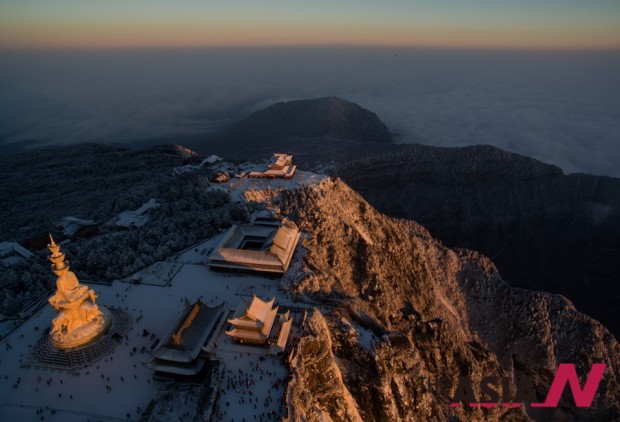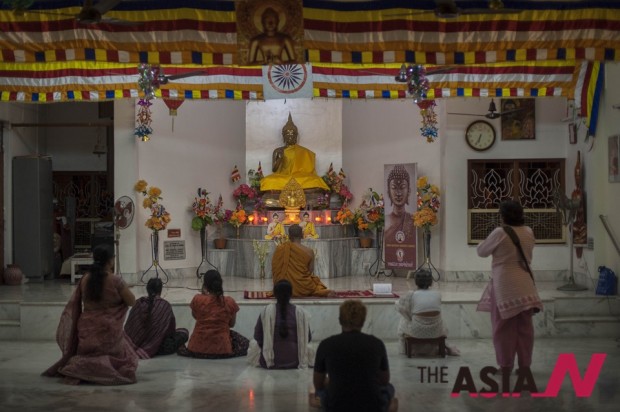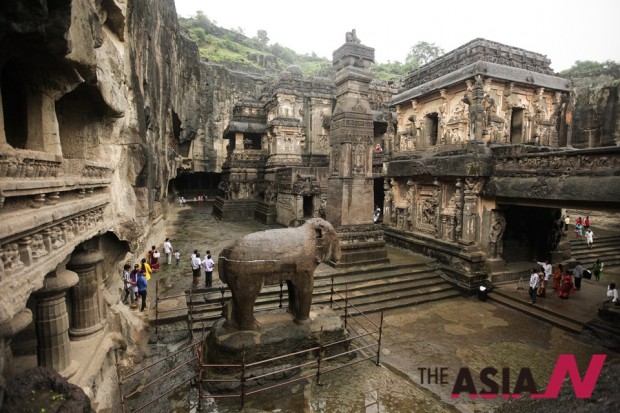가정집 절간서 장신구까지…아시아 불교 문화유산

* ‘아시아엔’ 연수 외국기자가 작성한 기사의 한글요약본과 원문을 함께 게재합니다.
[아시아엔=라드와 아시라프 기자·번역 김아람 기자] “모든 일은 마음이 근본이 된다. 마음에서 나와 마음으로 이루어진다. 청정한 마음을 가지고 말하거나 행동하면 즐거움이 그를 따른다. 그림자가 형상을 따르듯이.” 법구경(法句經)의 한 구절이다. ‘진리의 말씀’을 뜻하는 법구경은 올바른 삶을 위한 많은 조언들을 담고 있는 경전으로, 지금까지 불교도 사이에서 가장 널리 읽힌 책이라고 한다. 지금도 아시아 곳곳에서 큰 영향력을 발휘하고 있는 종교인 ‘불교’. 인도에서 생겨난 종교가 어떻게 아시아 전역에 널리 전파됐을까? 불교의 창시자 붓다(석가모니)는 본래 새로운 종교 창시나 개종시키는 데는 관심이 없었다고 한다. 다만 많은 사람들이 세상의 이치를 깨닫고 스스로 불행에서 벗어날 수 있도록 돕길 원했을 뿐이었으나, 아시아 전역에 걸쳐 붓다의 가르침이 널리 전파되면서 자연스레 ‘불교’가 발전하게 됐다.
수많은 불교서적을 영어로 번역한 저명 불교학자, 알렉산더 버진은 그의 논문 ‘불교가 아시아에 미친 영향’에서 “기원전 전통 소승불교가 인도에서 스리랑카로 전파된 것을 시작으로 중국, 태국, 라오스, 캄보디아, 인도네시아 등 아시아로 확산됐다”며 “이후 약간 다른 형태의 소승불교가 현재의 파키스탄, 카슈미르, 아프간, 이란, 우즈베키스탄 지역에 전파됐다”고 밝혔다. 또한 “이후 중국에서 발달된 대승불교가 한국과 일본, 북베트남으로 퍼져나갔다”고 했다. 그 옛날, 불교가 아시아 전역에 알려진 것은 국가 간 교류가 활발하게 일어났기 때문인 것으로 추정된다.
그 중에서도 태국은 아시아의 대표적인 불교국가다. 국민 95%가 불교를 믿고 승려 수만 17만명에 달한다. 남자의 경우 만 20세가 되면 일정기간 삭발하고 사찰에서 수행을 하는 전통이 오늘날까지 전해질 정도다. 초등학교 대부분에 사찰이 있어 어릴 적부터 자연스럽게 불교에 익숙해지고, 결혼과 출산, 장례에 이르기까지 모든 일상생활을 불교의식으로 치른다. 스님들 역시 사람들 사이에 다툼이 일어날 경우 이를 중재하고, 고아를 돌보아 주는 등 사회 유지의 중심역할을 해내고 있다. 태국의 각 가정은 가정의 행복과 번영을 기원하는 신을 모시는 작은 나무 사찰을 가지고 있는데, 이는 세상의 모든 것에는 신이 있다는 ‘애니미즘’이 불교와 결합돼 생겨난 태국 만의 이색문화다.
불교는 건축 양식에도 많은 영향을 미쳤다. 인도네시아는 1293년 인도에서 불교를 들여오면서 예술의 황금기를 맞이했다. 인도 건축물의 형태와 디자인, 장식 등에 영향을 받은 사원들이 전국 곳곳에서 세워졌다. 이 사원들의 벽면은 종교적 가르침을 묘사하는 조각과 그림으로 장식됐다. 특히 인도네시아 자바 섬에 있는 보로부두르 불교사원은 세계 최대 불교 유적지로, 동남아를 대표하는 유적지 가운데 하나다. 이 사원은 인도의 굽타 왕조와 그 이후의 예술에서 영향을 받은 건축물로, 여러 상징성을 지니고 있는 탑과 산 모양의 사원 등 매우 뛰어난 예술적 가치를 지닌 것으로 평가 받는다.
Buddhism and its many faces across Asia
“Blessed is the birth of the Buddhas; blessed is the enunciation of the sacred Teaching; blessed is the harmony in the Order, and blessed is the spiritual pursuit of the united truth-seeker,” said Buddha in his book Dhammapada, which is fittingly dubbed ‘Buddha’s path to wisdom’, explaining the merits of Buddhism.
Buddha didn’t ask others to denounce and give up their own religion and convert to a new one, for he was not seeking to establish his own religion. He was merely trying to help others overcome unhappiness and suffering that they were creating for themselves because of their lack of understanding. Later generations of followers were inspired by Buddha’s example and shared with others his methods that they found useful in their lives. This is how what is now called “Buddhism” spread far and wide.
Buddhism never developed a missionary movement, but Buddha’s teachings spread far and wide throughout Asia. In each new culture it reached, the Buddhist methods and styles were modified to fit the local mentality, without compromising the essential points of wisdom and compassion. Buddhism, however, never developed an overall hierarchy of religious authority with a supreme head. Each country to which it spread developed its own forms, its own religious structure and its own spiritual head. The most well-known and internationally respected of these authorities at present is the Dalai Lama of Tibet.
There are a number of faces of Buddhism, of which two major forms have survived: Hinayana, also known as Theravada, in Southeast Asia, and Mahayana, namely the Chinese and Tibetan traditions.
In his paper “Buddhism and its Impact on Asia,” Alexander Berzin tracks down how Buddhism actually spread: “Theravada traditions spread from India to Sri Lanka and Burma in the third century BCE, and from there to Yunnan in southwest China, Thailand, Laos, Cambodia, South Vietnam and Indonesia. Pockets of Indian merchants practicing Buddhism were soon found on the coast of the Arabian Peninsula and even as far as Alexandria, Egypt. Other forms of Hinayana spread from that time to modern-day Pakistan, Kashmir, Afghanistan, eastern and coastal Iran, Uzbekistan, Turkmenistan and Tajikistan. From this base in Central Asia, they spread further in the second century CE to East Turkistan (Xinjiang) and further into China, and in the late seventh century to Kyrgyzstan and Kazakhstan.
“The Chinese form of Mahayana later spread to Korea, Japan and North Vietnam. Another early wave of Mahayana, mixed with Hinduism, spread from India to Nepal, Indonesia, Malaysia and parts of Southeast Asia starting in about the fifth century. The Tibetan Mahayana tradition, which, starting in the seventh century, inherited the full historical development of Indian Buddhism, spread throughout the Himalayan regions and to Mongolia, East Turkistan, Kyrgyzstan, Kazakhstan, Siberia and the Kalmyk Mongol region near the Caspian Sea in European Russia.”

Buddhism faces across Asia:
“Follow not the vulgar way; live not in heedlessness; hold not false views; linger not long in worldly existence.”
The spread of Buddhism was aided by many factors, among them were the increase in trade, immigration and resettlements, and visits that included bringing parts of that culture back home. Artisans and craftsmen had as much of a role as monks in making people adopt and adapt to the rituals, texts, social norms and architectural style of Buddhism.
Buddhism had a huge effect on the culture of many Asian countries. Thailand, for example, was greatly influenced by Buddhist beliefs and traditions. Since A.D. 900, Thai people have owned spirit houses, miniature wooden houses where household spirits live. They present offerings such as food, drinks, flowers, and candles to keep the spirits happy. If they are unhappy, they will inhabit larger households and cause chaos. Spirits must be cared for because they are believed to protect people, grant wishes, and bring good luck and health.
While in Vietnam, Buddhist monk Van Hahn helped King Ly Cong Uan stabilize power and create the Ly Dynasty after the fall of the T’ang Dynasty. Ly owed it to Hahn, leading Buddhism to become the state religion. Vietnam combines Buddhist teachings of Pure Land and Zen, and their meditation center and Buddhism schools are acknowledged across Asia. Pure Land teaches that only through devotion to and guidance from Amitabha Buddha (Buddha of Pure Land), one can be reborn in the Pure Land, a paradise where enlightenment can be reached. Zen purifies wisdom. It is the realization of emptiness and the ambition for enlightenment allows compassion to grow. It focuses concentration and calms the frustrated mind.

It wasn’t just a cultural influence; some of the architectural designs that set Asia apart have been heavily influenced by Buddhism. In Indonesia, the golden age of art began in 1293 due to Buddhism deriving from India. As a result, countless numbers of Hindu-Buddhist brick temples were built with Indian construction techniques, architectural style, and decorations. Temple walls made of relief sculptures usually depict stories or religious teachings. Manasara, an Indian religious book, describes Canonic rules held by Indian builders. Builders had once believed that the rules were sacred and held magical powers. A construction that was built according to the rules would benefit the ruler who ordered the construction, and the builder himself. It would also bring riches and happiness to the people. Statues of their gods and goddesses (such as Vishnu, Brahma, and Tara) were placed inside these temples.
While in China, literature was one of the aspects heavily characterized by Buddhism. The Diamond Sutra is the world’s first, oldest, and surviving printed book and it is one of China’s marks of Buddhism. It is a Mahayana scripture made of seven strips of paper joined together, offering meditations on illusion and perception. It was originally written in Sanskrit and translated into the Diamond Sutra in the year 868. It acts as an antidote for the suffering and must be achieved through wisdom.
“The realization of emptiness of all things is the key step to saving all beings.”





